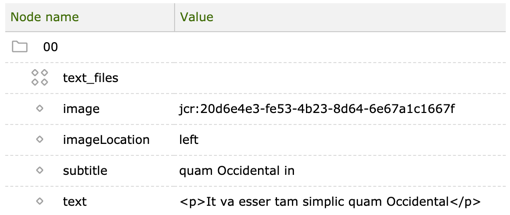Templating function arguments and return types
When using a templating function you pass some parameters and get something back. The types of these arguments and returned objects are the same in many methods, and it is helpful to know these types. Read the Javadoc of typical templating function return types even if you do not know Java. The Javadoc gives you an idea what else you could do with the returned objects.
Node and ContentMap
Some functions require Node, whereas others ask for info.magnolia.jcr.util.ContentMap.
javax.jcr.Node
The type from the JCR API. Since JCR is a tree oriented data structure, this type is useful when you want to find other nodes above (parent, ancestors) or below (children) the current node.
info.magnolia.jcr.util.ContentMap
This Magnolia type is a wrapper for the above mentioned JCR node. ContentMap provides easy access to the node properties and is useful when you want to render these properties.
<h1>${content.title}</h1>ContentMap and Node rendering context objects
-
The rendering context object
contentprovides the current content node of the context asinfo.magnolia.jcr.util.ContentMap. -
The rendering context object
model.nodeprovides the current content node of the context asjavax.jcr.Node, see model. If you have no model but need this type, usecmsfn(content).
cmsfn
provides methods to convert javax.jcr.Node to
info.magnolia.jcr.util.ContentMap and vice versa.
Node and ContentMap collections
Both types java.util.List and java.util.Collection either with Node or with ContentMap items might be required as arguments.
-
java.util.List<info.magnolia.jcr.util.ContentMap> -
java.util.List<javax.jcr.Node> -
java.util.Collection<javax.jcr.Node> -
java.util.Collection<info.magnolia.jcr.util.ContentMap>
Keep in mind that
List
extends
Collection.
This means that if a Collection is required, you can pass a List, but
this does not work the other way round.
cmsfn
provides methods to convert Collection<Node> to List<ContentMap> and
from Collection<ContentMap> to List<Node>.
Example: Get the children nodes of the node of the current nodes, convert the returned list of nodes into list of contentMap items and iterate over the list of contentMap items.
[#assign currentNode = cmsfn.asJCRNode(content)]
[#assign childrenNodesAsContentMaps = cmsfn.asContentMapList(cmsfn.children(currentNode, "mgnl:page"))]
[#list childrenNodesAsContentMaps as child ]
<li>${child.title}</li>
[/#list]
Item, Asset, Folder, Map (of an asset), AssetRendition
itemKey of an asset
Some methods in
damfn
require a String argument called itemKey. An item key uniquely
identifies an asset among different asset providers.
When JCR is used as asset provider, the item key is composed of
jcr:<node-UUID>, for instance
jcr:20d6e4e3-fe53-4b23-8d64-6e67a1c1667f. Typically you need to get
the item key from a content node that is created when a component is
saved in the JCR.
Example: A component node contains a reference to an image.

In a Java context, if you have an asset and want to know its item key as a String, use:
asset.getItemKey().asString()In a FreeMarker context, if you have an asset and want to know its item key as a String, use:
[#assign itemKey = myAsset.getItemKey().asString()]info.magnolia.dam.api.Item
info.magnolia.dam.api.Item is the common supertype of Asset and Folder. Some methods of the damfn will return Item.
info.magnolia.dam.api.Asset
An asset is a digital resource with associated metadata. This interface provides many methods that you may want to call directly within your script.
Example:
[#assign myAsset = damfn.getAsset("jcr", "/photos/dilbert.jpg")!]
get the link of an asset to display an image <img src="${myAsset.getLink()}"/> - when the asset is an image
or a download link: <a href="${myAsset.getLink()}">Link to the asset</a>
info.magnolia.dam.api.Folder
A Folder represents a structural item holding Assets. Depending on the provider, this can be directly mapped to the concept of folders/directories (JCR, FileSystems, and so on); for others this might map to the concept of albums, playlists, sets, and so on.
Example:
[#assign photosFolder = damfn.getFolder("jcr", "/photos")]
The folder ${photosFolder.name} contains the following images:
<ul>
[#list photosFolder.getChildren() as item]
<li>${item.getName()}</li>
[/#list]
</ul>
Map of an asset and its metadata
The DAM templating functions
(damfn)
provide a method which returns a java.util.Map containing all the bean
properties of the asset.
[#assign myAsset = damfn.getAsset("jcr", "photos/pool.jpg")!]
[#assign myAssetMap = damfn.getAssetMap(myAsset)]
fileSize: ${myAssetMap.fileSize}
folder: ${myAssetMap.caption?string}
name: ${myAssetMap.name}
title: ${myAssetMap.title}
caption: ${myAssetMap.caption}
copyright: ${myAssetMap.copyright}
See info.magnolia.dam.api.Asset for all public methods indicating the available properties.
Additionally, the map may contain further nested maps with the
properties of classes implementing
info.magnolia.dam.api.metadata.AssetMetadata. The
metadata sub maps are collected under the key metadata.
If the asset is provided by info.magnolia.dam.jcr.JcrAssetProvider (that is, if
the asset is derived from the JCR workspace dam), the following submaps
are provided on the asset map:
| Metadata class | Key | Composed key | Example |
|---|---|---|---|
|
|
|
|
|
|
|
|
[#assign myAsset = damfn.getAsset("jcr", "photos/pool.jpg")!]
[#assign myAssetMap = damfn.getAssetMap(myAsset)]
width: ${myAssetMap.metadata.mgnl.width}
format: ${myAssetMap.metadata.dc.format}
info.magnolia.dam.api.AssetRendition
info.magnolia.dam.api.AssetRendition is a
variation on a asset, for a specific MimeType.
The renditions are defined per Theme in the
Site. For instance the node
/modules/site/config/themes/examples-theme/imaging/variations/small-square
defines in the theme examples-theme a rendition named
small-square.
Site and Theme
TemplateDefinition
Read Template definition to get an idea of what a template definition is. Some templating functions require a info.magnolia.rendering.template.TemplateDefinition object as a parameter.
At least the template definition of the current template is always
available as context object - see
rendering
context object def.
JsonBuilder
A JsonBuilder object is a builder for converting JCR nodes into JSON. The class offers many public
methods to adapt the node structure and properties. JsonBuilder is
the return types of all methods of
jsonfn
(JsonTemplatingFunctions)
and of most of the methods of JsonBuilder. The #print method returns
JSON as a string.
Using public method of returned objects
If you know the type of the returned object of a templating function, you can apply the public methods to the object to retrieve the return value of these methods. This works in almost every case but not for maps such as info.magnolia.jcr.util.ContentMap.
Example:
[#assign currentNode = cmsfn.asJCRNode(content)]
<i>The path of the underlying jcr node in this context is ${currentNode.getPath()}.</i>Notes:
-
Line 1: Assign an object of type javax.jcr.Node to the variable
currentNode. -
Line 2: Use the
getPath()method which is a public method defined in javax.jcr.Node. It returns a String.
The script will print for instance: The path of the underlying jcr node in this context is /home/products.